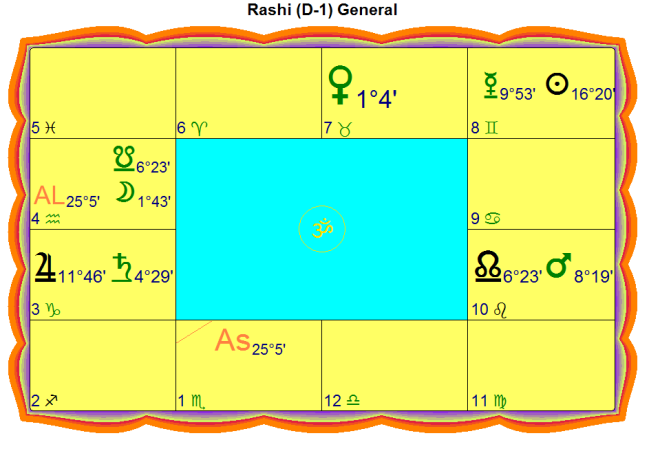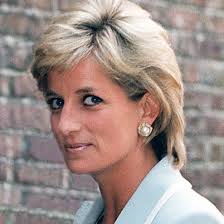Of the many astrological factors that are significant in the analysis of a horoscope, few are more so than the condition of the ascendant ruler. The sanskrit word for ‘ascendant’ is ‘lagna‘, and the word for ‘ascendant lord’ is ‘lagnesha’. I’ll be using the sanskrit term throughout this article.
So why is the lagnesha so important and what does it signify? It is important because, as lord of the lagna it shows a powerful point of focus for one’s interaction with the world. The lagnesha, via it’s sign and house position, as well as it’s nakshatra, indicates how and where we “place ourselves” in life, and it’s interaction with the rest of the chart shows whether we do this with ease or struggle. The lagna shows our overall vitality and sense of self-confidence and the position of the lagnesha indicates in what area of life we feel most balanced and confident in ourselves. It is, therefore, a reliable guide to our role in society, and along with the Moon (Chandra) it is the most important planet in the horoscope. Lagnesha shows one’s physical orientation toward a particular type of activity ( sign) and social environment (house). Also, lagnesha profiles how the individual will fare socially in the outside world; how others view him and treat him, and whether one has found a “good fit” with the external social environment. This planet will contribute significantly toward happiness and self-satisfaction at the active, outward, bodily level.
The condition of the lagnesha must be analysed closely in order to determine the native’s ability to function at an optimum level of performance. Drishti from malefics – both natural and functional – will damage the normal, correct function of the lagnesha while drishti from benefics will enhance and broaden the expression, especially if the benefic also happens to be L5 or L9.
Another point to consider is whether the lagnesha is swakshetra, uchchamsha, or mulatrikona, as each of these positions will empower the lagnesha and increase it’s beneficial effect. By contrast, if lagnesha is neechcha (fallen) it brings potentially serious difficulties of one form or another. These problems may take the form of a personality disorder for example, or perhaps a physical impediment. (Remember that the lagnesha is strongly connected to one’s physical vitality and appearance.) A fallen lagnesha is incapable of expressing it’s natural energies in a so-called “normal” fashion; or in a way that is socially acceptable, consequently mistakes are often made that create difficulties for the person and those around him. The bhava occupied will provide strong clues as to the area of life that is most affected. Of course, if the neechcha lagnesha achieves relief via neechcha bhanga yoga, then the initial difficulty or embarrassment is eventually turned to strength and success.
To illustrate the way in which the lagnesha can show a very powerful focal point, not only in one’s life in the world but also via the character, we’ll take a look at an example horoscope: that of Diana, Princess of Wales¹
As can be seen from the chart, Diana was born with the intense, deep, emotional and turbulent sign of Scorpio rising at the lagna, which makes Mars the all-important lagnesha. Mars is placed in Leo in the 10th house of public visibility and reputation. The rising Nakshatra is Jyeshtha, the symbols for which are an earring and an umbrella. The earring is a symbol of Vishnu’s discus, and the umbrella symbolizes protection and status. According to Shil-Ponde. (1939). “Hindu Astrology Joytisha-Shastra” . p 98, this nakshatra when rising produces one who is “independent, self-sufficient, capable, dignified, proud.” He tells us that such a woman ” …has a tendency to dramatize herself, and that she will, at some time in her life, occupy a very influential position and be greatly respected.” Add to this the position of lagnesha in the 10th house, which tells us that she would feel most natural and comfortable being a public icon. This is an exceptionally public person whether she consciously chooses this exposed role or not. She would like to identify with prominent social positions and be recognized for a lifetime of public service. Further, and extremely telling, we see Mars placed in the nakshatra of “Magha” ( 00° 00′ Simha/Leo -13°20′ Simha/Leo ), whose symbols are a palanquin, and a royal chamber containing a throne. Someone with their lagnesha in this nakshatra and angular is going to make their mark upon the world in no uncertain terms, and Diana was no exception. She literally became one of the British Royal Family. A princess, no less!
Mars is the planet of action, drive and initiative. Diana was a passionate champion of the rights of disadvantaged people and did much to highlight the plight of people living with HIV or AIDS, offering a visible helping hand to those in need. She used her high profile to raise awareness and funds for charitable causes while fighting the stigma associated with “unpopular” causes. Two of the major charities that she became champion of were the National AIDS Trust and the HALO Trust, which seeks to ban the use of landmines as weapons of war. The photographs of Diana taken in January 1997 touring a minefield in Angola wearing a helmet and flak jacket were seen all over the world. This lady was no sweet, sugar-coated princess; Diana was a woman of deep, passionate feelings who wasn’t afraid to break taboos and take risks on behalf of those less fortunate.
Rahu is the great taboo breaker and here we see him tightly conjunct lagnesha Mars. Rahu acts to amplify whichever planet he touches and here we see an amplification of the warrior energy. Diana was very competitive and loved to pit herself against challenges. She fought for social change and those less fortunate and she wasn’t afraid of confrontation in order to bring it about. As an interesting aside, like Ginger Rogers – who also had this conjunction, Diana was an excellent dancer.
More problematically for Diana, this Mars-Rahu conjunction opposes a Moon-Ketu conjunction in the 4th house and no doubt this contributed greatly towards her many emotional problems. The 4th house and the Moon are both closely associated with the mother. Diana’s mother, Frances Shand Kydd, divorced her father in 1968 and left Diana in the care of her father. Diana was once quoted as saying that her childhood was “very unhappy and unstable….The biggest disruption was when Mummy decided to leg it. That’s the vivid memory we have — the four of us [including her brother and two sisters]. … People took sides. Various people didn’t speak to each other. For my brother and I it was a very wish-washy and painful experience,” For her part, Diana’s mother has been quoted as describing her relationship with Diana as “sometimes turbulent”. This is exactly what we’d expect to find when a Moon-Mars opposition is joined closely to the Rahu-Ketu axis. Ketu with the Moon tends to disconnect one from the mother, either through separation, death, or simply because the mother was emotionally distracted, withdrawn, distant or unstable. In Diana’s case the mother left and never truly came back to her. Testifying in 2002 at the theft trial of Diana’s former butler, Paul Burrell, Shand Kydd said she had not spoken to Diana in the last four months of her life and that the princess had returned her letters unopened. Shand Kydd agreed with a statement by Burrell’s lawyer, Lord Carlile, that Diana, “like many of us, could sometimes be a little tempestuous.”
The Moon has rulership over emotions and feelings, as well as the way in which we nurture and protect ourselves. Here the opposition from Mars shows that in many ways Diana was her own worst enemy. Mars wants to attack and when it afflicts the Moon one’s anger is often internalised and can in times of stress erupt in displays of childlike and highly disruptive behaviour. When the Moon-Mars opposition is tacked onto the Rahu-Ketu axis it may present as displays of greed (Rahu) followed by apathy (Ketu). It’s easy to be wise after the fact but I believe this astrological pattern describes Diana’s bouts of Bulimia – an illness characterised by binge eating followed immediately by self-induced vomiting. In Diana’s case there would have been a lot of anger attached to this behaviour. Mars is, after all, Lord 6, and the 6th house is the house of sickness and imbalance.
Mars is in the 7th house from Chandra/Moon. Using Chandra as an alternate ascendant – a practice well used in jyotish – the house opposite the Moon and planets contained within it says a great deal about the marriage situation, the character of the spouse, and in particular, a more private, intimate and emotionally acute level of marital reality. It also describes the overall emotional constitution of the spouse. In Diana’s radix Chandra/Moon occupies bhava 4, therefore the 7th from this position is bhava 10, describing the spouse to be of high-rank and dignified social position or of socially secure moral reputation. Mars in 7th from Chandra describes a partner who is athletic, bold, a military man or sportsman (Charles has been both ) and also someone who be overly assertive and selfish. Rahu here describes a dramatic rise from one’s station of birth via extraordinary or exotic marriage. The partner may seem like a pretender, a charlatan, a poseur. Remember Charles’ surreptitious relationship with Camilla, which appears to have been in full flow even on the day he married Diana? In the beginning the desires of the spouse will energize the one with Rahu-7 but as time goes on Rahu-7 (who has unambitious Ketu in Chandra lagna) may feel used by the instrumental deviousness of the spouse. All of these circumstances obtained in the marriage and quite intensely, since Rahu is conjoined to the lagnesha Mars.
In summary, the all-important lagnesha reveals many fine details about one’s character, life and destiny. It’s position by sign, house, and nakshatra – not only from the radix lagna but also from Chandra/Moon lagna is second in importance only to that of the Moon itself and should never be overlooked in analysis. In Diana’s case the lagnesha painted a remarkable portrait of her complex and fascinating personality. It was even active on the day she died – Aug 31st 1997, transiting the 12th house (sorrow, loss, clandestine matters ), and aspecting Jupiter, the active Dasha lord and also the maraka for Scorpio rising, being lord of the 2nd house.
Examine the lagnesha closely; it will reward your study well.
¹ July 1st 1961; 7.45pm BST; Sandringham, UK. 52° 50′ N – 0° 30′ E.
There is another speculative time for Diana’s birth: 2:00pm BST, which is based on a statement allegedly made by Diana’s mother that she was born “just before the start of play at Wimbledon”. This chart has a Virgo lagna and in my view is not descriptive of Diana’s life and character.


You must be logged in to post a comment.